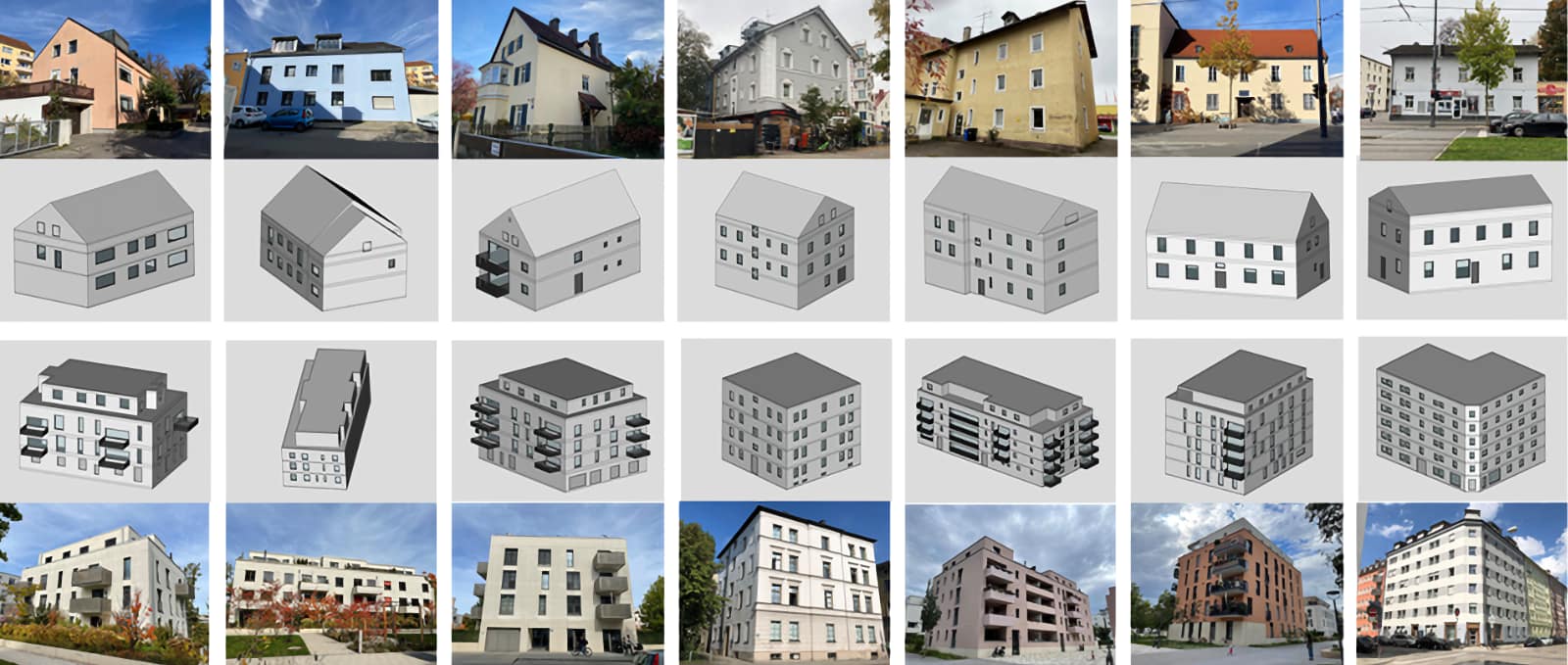Downloads
DOI:
https://doi.org/10.47982/jfde.2023.2.A2Keywords:
semi-automated data acquisition, prefabricated façade panels, building envelope renovation, open data, interoperability, IFCAbstract
A key barrier in building-facade renovation processes is that, contrary to new designs, an initial building model where the design process is based rarely exists, and the technologies usually employed to create it (e.g., based on point cloud scanning) are costly or require modeling skills. This situation is a clear limitation, especially in early decision stages, where the level of detail required is not very high, and the analysis and studies to consider the renovation plan (e.g., simplified energy simulations and renovation potential, or estimation of the number, types, and dimensions of the prefabricated modules incorporating solar panels) highly depend on such digital models. This paper introduces a process that, based on freely available data such as open GIS sources (local Cadasters, OpenStreetMap…) and façade images, can semi-automatically generate the 3D building model of the existing conditions, and in a second step also suggests the prefabricated facades module layout for building upgrades. Additionally, no onsite visit is needed. When the upgrade is focused on the façade, a big opportunity is identified for generating the building model and a realistic representation of its envelope, only using online data sources as input. The process developed consists of a set of easy-to-use software tools that can be used independently or combined in a workflow, depending on the available data and starting conditions. Time saving is very clear and costs can be reduced.
How to Cite
Published
Issue
Section
License
Copyright (c) 2023 Kepa Iturralde, Peru Elguezabal, Asier Mediavila

This work is licensed under a Creative Commons Attribution 4.0 International License.
Authors or their institutions retain copyright to their publications without restrictions.
References
Alizadehsalehi, S., & Yitmen, I. (2016). The Impact of Field Data Capturing Technologies on Automated Construction Project Progress Monitoring. Procedia Engineering, 161, 97–103. DOI: https://doi.org/10.1016/j.proeng.2016.08.504 DOI: https://doi.org/10.1016/j.proeng.2016.08.504
Bertim. (2019). Viewed on the 28 August 2023. [Online]. Available: https://cordis.europa.eu/article/id/125299-digitising-building-energy-renovation
Bosché, F. (2009). Automated recognition of 3D CAD model objects in laser scans and calculation. Advanced Engineering Informatics, pp. 107-119. DOI: https://doi.org/10.1016/j.aei.2009.08.006
European Commission. (2020). Industrialisation of building envelope kits for the renovation market (IA). Viewed on the 14 March 2020. [Online]. Available: https://ec.europa.eu/info/funding-tenders/opportunities/portal/screen/opportunities/topic-details/lc-eeb-04-2020;freeTextSearchKeyword=;typeCodes=0,1;statusCodes=31094501,31094502,31094503;programCode=null;programDivisionCode=null;focusAreaCode=null;cross.
European Commission. (2021a). NUTS - Nomenclature of territorial units for statistics. Retrieved from https://ec.europa.eu/eurostat/web/nuts/background.
European Commission. (2021b). Correspondence tables - Postcodes and NUTS. Retrieved from https://ec.europa.eu/eurostat/web/nuts/correspondence-tables/postcodes-and-nuts.
European Construction Sector Observatory. (2021). Digitalisation in the Construction Sector. Analytical Report. Retrieved from https://ec.europa.eu/docsroom/documents/45547.
European Commission. (2022). PVGIS API Non-Interactive Service. Retrieved from https://joint-research-centre.ec.europa.eu/pvgis-photovoltaic-geographical-information-system/getting-started-pvgis/api-non-interactive-service_en.
Green Building XML (2022). gbXML schema. Retrieved from https://gbxml.org.
Iturralde, K., et al. (2022). Solution Kits for automated and robotic façade upgrading. In Proceedings of the 39th International Symposium on Automation and Robotics in Construction, 2022, pp. 414–421. DOI: https://doi.org/10.22260/ISARC2022/0057 DOI: https://doi.org/10.22260/ISARC2022/0057
Iturralde, K., et al. (2021). Compilation and assessment of automated façade renovation, in Proceedings of the 38th International Symposium on Automation and Robotics in Construction, 2021, pp. 797-804. DOI: https://doi.org/10.22260/ISARC2021/0108 DOI: https://doi.org/10.22260/ISARC2021/0108
Izquierdo Asensi, F. (2000). Geometría Descriptiva. Editorial Paraninfo. ISBN: 9788493366872.
João Ricardo Lourenço (2017), Open elevation. Retrieved from https://www.open-elevation.com/.
Kadhim, N., Mhmood, A. D., & Abd-Ulabbas, A. H. (2021). The creation of 3D building models using laser-scanning data for BIM modelling. IOP Conference Series: Materials Science and Engineering, 1105(1), 012101. DOI: https://doi.org/10.1088/1757-899X/1105/1/012101 DOI: https://doi.org/10.1088/1757-899X/1105/1/012101
Kim, C., Son, H., Kim, C., (2013). Fully automated registration of 3D data to a 3D CAD model for project progress monitoring. Automation in Construction, pp. 587-594. DOI: https://doi.org/10.1016/j.autcon.2013.01.005
Knotten, V., Lædre, O., & Hansen, G. K. (2017). Building design management – key success factors. Architectural Engineering and Design Management, 13(6), 479–493. DOI: https://doi.org/10.1080/17452007.2017.1345718 DOI: https://doi.org/10.1080/17452007.2017.1345718
Ladybug Tools. (2020). Aragog gbXML viewer. https://www.ladybug.tools/spider/gbxml-viewer/r12/gv-app/gv-app.html
Löwner, M. O., Benner, J., Gröger, G., & Häfele, K. H. (2013). New Concepts for Structuring 3D City Models – An Extended Level of Detail Concept for CityGML Buildings. In Computational Science and Its Applications – ICCSA 2013, pp. 466–480. DOI: https://doi.org/10.1007/978-3-642-39646-5_34 DOI: https://doi.org/10.1007/978-3-642-39646-5_34
Mediavilla, A., Elguezabal, P., & Lasarte, N. (2023). Graph-Based methodology for Multi-Scale generation of energy analysis models from IFC. Energy and Buildings, 282, 112795. DOI: https://doi.org/10.1016/j.enbuild.2023.112795 DOI: https://doi.org/10.1016/j.enbuild.2023.112795
Noori, A., Saruwono, M., Adnan, H., & Rahmat, I. (2016). Conflict, Complexity, and Uncertainty in Building Refurbishment Projects. In InCIEC 2015, pp. 251–258. DOI: https://doi.org/10.1007/978-981-10-0155-0_24 DOI: https://doi.org/10.1007/978-981-10-0155-0_24
Oluleye, B. I., Chan, D. W. M., Antwi-Afari, P., & Olawumi, T. O. (2023). Modeling the principal success factors for attaining systemic circularity in the building construction industry: An international survey of circular economy experts. Sustainable Production and Consumption, 37, 268–283. DOI: https://doi.org/10.1016/j.spc.2023.03.008 DOI: https://doi.org/10.1016/j.spc.2023.03.008
Omar, T., & Nehdi, M. L. (2016). Data acquisition technologies for construction progress tracking. Automation in Construction, 70, 143–155. DOI: https://doi.org/10.1016/j.autcon.2016.06.016 DOI: https://doi.org/10.1016/j.autcon.2016.06.016
Polly, B., Kruis, N., Roberts, D.R. (2011). Assessing and improving the accuracy of energy analysis for residential buildings. US Department of Energy, Energy Efficiency and Renewable Energy, Building Technologies Program, National Renewable Energy Laboratory. URL: https://www.nrel.gov/docs/fy11osti/50865.pdf DOI: https://doi.org/10.2172/1219220
Volk, R., Stengel, J., & Schultmann, F. (2014). Building Information Modeling (BIM) for existing buildings — Literature review and future needs. Automation in Construction, 38, 109–127. DOI: https://doi.org/10.1016/j.autcon.201 DOI: https://doi.org/10.1016/j.autcon.2013.10.023
